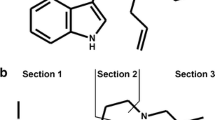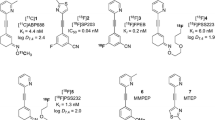Summary
The plasma concentrations and urinary excretion of dihydroergotamine and its metabolites have been measured after a single oral administration of 3 mg tritium-labelled drug to 6 male volunteers. The plasma level of non-volatile radioactivity declined biphasically with α- and β-phase half-lives of 2.1 h and 32.3 h, respectively. The peak plasma concentration was reached within 3.2h. Urinary excretion of total non-volatile radioactivity was low, amounting to 1.0% of the dose. The parent drug and four metabolites could be quantitated in urine and plasma samples. Metabolite 4 (8′-hydroxy-dihydroergotamine) was isolated from incubates of rat and monkey liver microsomal preparations. In human liver microsomal incubates, metabolite 4 was shown to be the primary metabolite of dihydroergotamine. In receptor binding studies performed with mammalian brain preparations, metabolite 4 had IC50-values at 6 monoaminergic binding sites similar to those of dihydroergotamine. Thus, it appears that the active principle consists at least of dihydroergotamine and its 8′-hydroxy derivative. As the concentration of metabolite 4 exceeded 5–7 times that of dihydroergotamine in urine and plasma, the bioavailability of dihydroergotamine should be reevaluated, taking into account the plasma concentrations of the parent drug and of its acitve metabolite, 8′-hydroxydihydroergotamine.
Similar content being viewed by others
References
Little PJ, Jennings GL, Skews H, Bobik A (1982) Bioavailability of dihydroergotamine in man. Br J Clin Pharmacol 13: 785–790
Aellig WH, Nüesch E (1977) Comparative pharmacokinetic investigations with tritium labeled ergot alkaloids after oral and intravenous administration in man. Int J Clin Pharmacol 15: 106–112
Bobik A, Jennings G, Skews H, Esler M, McLeane A (1981) Low oral bioavailability of dihydroergotamine and first pass extraction in patients with orthostatic hypotension. Clin Pharmacol Ther 30: 673–79
Müller E (1984) Pharmacological actions of the main metabolites of dihydroergotamine. Eur J Clin Pharmacol (in press)
Aellig W (1984) Investigation on the venoconstrictor effect of 8′-hydroxy-dihydroergotamine — the main metabolite of dihydroergotamine — in man. Eur J Clin Pharmacol 26: 239–242
Meier J, Schreier E (1976) Human plasma levels of some antimigraine drugs. Headache 16: 96–104
Matsubara T, Koike M, Touchi A, Tochino Y, Sugeno K (1976) Quantitative determination of cytochrome P-450 in rat liver homogenate. Anal Biochem 75: 596–603
Peroutka SJ, Snyder SH (1979) Multiple serotonin receptors: differential binding of [3H]5-hydroxyptamine, [3H]lysergic acid diethylamide and [3H]spiroperidol. Mol Pharmacol 16: 687–699
U'Prichard DC, Greenberg DA, Snyder SH (1977) Binding characteristics of a radiolabelled agonist and antagonist at central nervous system alpha noradrenergic receptors. Mol Pharmacol 13: 454–473
Burt DR, Creese I, Snyder SH (1976) Properties of [3H]haloperidol and [3H]dopamine binding associated with dopamine receptors of calf-brain membranes. Mol Pharmacol 12: 800–812
Creese I, Schneider R, Snyder SH (1977) [3H]spiroperidol labels dopamine receptors in pituitary and brain. Eur J Pharmacol 46: 377–381
Closse A, Frick W, Hauser D, Sauter A (1980) Characterization of [3H]-bromocriptine binding to calf caudate membranes, in psychopharmacology and biochemistry of neurotransmitter receptors. Dev Neurosci 11: 463–474
Maurer G (1977) Isolement et structure de métabolites biliaires de la dihydroergokryptine chez le rat. Thèse de docteur d'état es-sciences présentée devant l'Institut National des Sciences Appliquées de Lyon et l'Université Claude Bernard Lyon I. No d'ordre IDE 77014
Maurer G, Schreier E, Delaborde S, Loosli HR, Nufer R, Shukla AP (1982) Fate and disposition of bromocriptine in animals and man. I: Structure elucidation of the metabolites. Eur J Drug Metab Pharmacokinet 7: 281–292
Closse A, Bolliger G, Dravid A, Frick W, Hauser D, Pfäffli P, Sauter A, Tobler HJ (1983) Structural modifications of the ergopeptine molecule and their differential influence on the affinities to different receptor binding sites. A structure affinity analysis. In: Segawa T et al. (eds) Molecular pharmacology of neurotransmitter receptors. ed Raven Press, New York, pp 269–279
Maurer G, Schreier E, Delaborde S, Nufer R, Shukla AP (1983) Fate and disposition of bromocriptine in animals and man. II: Absorption, elimination and metabolism. Eur J Drug Metab Pharmacokinet 8: 51–62
Nimmerfall F, Rosenthaler J (1976) Ergot alkaloids: hepatic distribution and estimation of absorption by measurement of total radioactivity in bile and urine. J Pharmacokinet Biopharm 4: 57–66
Author information
Authors and Affiliations
Rights and permissions
About this article
Cite this article
Maurer, G., Frick, W. Elucidation of the structure and receptor binding studies of the major primary, metabolite of dihydroergotamine in man. Eur J Clin Pharmacol 26, 463–470 (1984). https://doi.org/10.1007/BF00542142
Received:
Accepted:
Issue Date:
DOI: https://doi.org/10.1007/BF00542142




